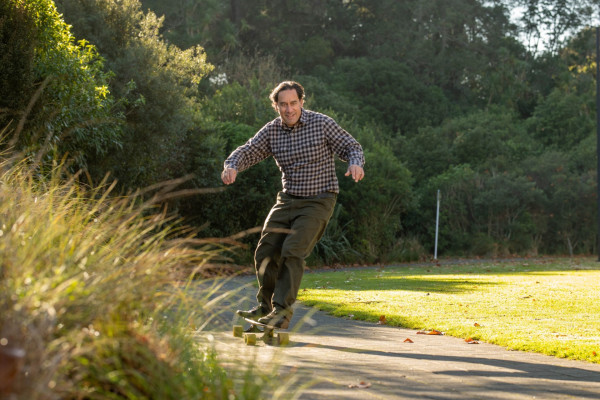Posted on 20 June 2023
Te Au o Te Moana – Voice of the Ocean: Shaun Awatere
- News
- 20 Minutes to read
Shaun Awatere leads the Tangaroa research theme, which places Māori at its centre and aims to promote and support Māori-led or partnered projects to enable direct benefits to those iwi and hapū involved.
“My interest is looking at how people behave towards the environment and how their actions might affect future generations. A lot of my work looks at the interface between people, their behaviour, and their roles in practices, that are put in place to achieve their priorities.”
Published June 2023
Interview by Desna Whaanga-Schollum
Shaun Awatere – Tangaroa theme leader
Tell me a little about yourself, your connection with Sustainable Seas, and why you got involved
This National Science Challenge tackles important kaupapa such as the sustainability of the marine natural environment, and kaitiakitanga. For kaupapa that I've been involved in, it doesn't matter whether it's with sustainability of the urban environment, sustainability of the whenua, or sustainability of the ngahere. From a Māori perspective, it's difficult to silo them and put them into boxes. Because whakapapa is a wholistic lens and perspective, that sees these connections right across all those different domains. What we do to the whenua is going to have an impact on the water and what we do to our waterways is going to impact on our marine and coastal environments. So, for me to be involved in Sustainable Seas, I'm not a marine researcher myself, but come from that kaupapa Māori research approach and from a social scientist approach.
My interest is looking at how people behave towards the environment as well as how potentially their actions might affect future generations. A lot of my work looks at the interface between people, their behaviour, and their roles in practices that are put in place to achieve their priorities.
Often there's a juxtaposition or a dichotomy between what Māori aspire to and what wider society aspires to. For Māori, there's a need to ensure that the environment is in a state that our children and mokopuna can realise the benefits that we have. And on the other side, wider society, driven by capitalism, is fundamentally driven by the need to accumulate wealth, regardless of the negative impacts that it creates.
The interface between people and the environment is where I do a lot of my work in terms of looking at the policies, the legislation, and the strategies required to align wider society towards an Indigenous approach to looking after the environment.
How do you feel connected to the moana?
The moana is a source of utility and a source of personal, tangible wellbeing for me, and there's also a metaphysical connection. Growing up I knew kina, pāua, crayfish, those things that sustain the tinana. As I grew into a teenager, I became more connected to the environment recreationally, and also on a metaphysical level, through the activity of surfing, of catching waves.
When you do that, when you get out into the coastal environments diving, swimming, or surfing, you become part of something that’s far bigger than what you are as a human being. It makes you appreciate that you're part of this wider ecosystem and there are bigger forces at play that change and shape the way we live and survive on this planet.
This probably best describes the connection that I personally have with the environment. I see myself as part of the environment, rather than seeing the environment as something to extract from and take from. But my thoughts are around, how do we care for the environment, look after the environment, manaaki it in a way that I personally can receive some benefits from it, but also ensure that everyone else can share in it, and that future generations can share in it as well.
Can you share a memory where you felt connected to the moana?
One of my fondest memories is going crayfishing with my dad. He was such an awesome swimmer and diver, and there was one time we were walking along this rocky shelf around Tatapouri just north of Gisborne. We had a sack of kina, and we were after some crays on our way back to the car. My dad found this rocky shelf underneath the reef that we were walking on. It was like a channel and the rocks were on a diagonal slope so we could see there was a channel going underneath the reef.
And somehow Dad decided he still wanted some of those crays. He dived down underneath the rocky shelf; went underneath the rocks and the reef and went looking for crays. He managed to secure a couple for us to have a feed. But I just thought, man, this guy is such an awesome swimmer, as well as being fearless and confident enough to be able to go down and get those crays — mind you, hunger can do that to you, or the craving for kai can do that to you.
He put himself at risk. The best personal memories for me are probably when you're in a precarious situation out on the water and you survive an event, or you lose your equipment out on the water, and then you make it back to shore. Or you get thrown about by big waves — there's nothing that makes you feel more alive.
I think that's probably what the personal connection that I have with the ocean is about — that kind of thrill, that adrenaline that you get when you're in those situations.
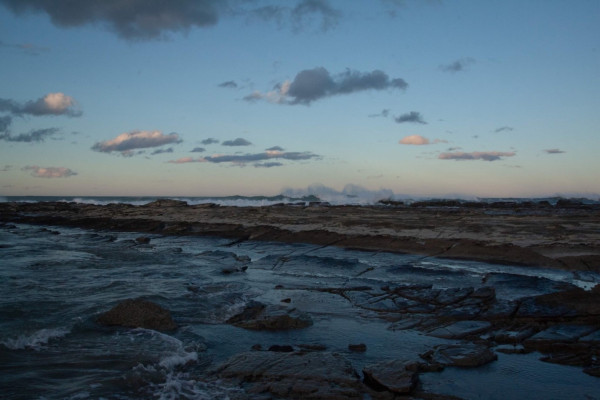
Waves Crashing, Auroa Point, Māhia. Desna Whaanga-Schollum, 2023
You were saying that you're part of something bigger, that the ocean is definitely the boss, not you?
That's it. It’s growing up with respect for the ocean, and knowing that you can get kai from the moana, you can surf some awesome waves in the moana, but at any time you can be put in a precarious situation. You have to be prepared, and you have to respect Tangaroa every time you go into it, no matter how the conditions are.
Sometimes, when you get out onto the water in really precarious situations, you know that your training and experience can help mitigate some of the impacts of being put into certain situations — whether you're losing equipment or getting smashed by waves — that type of learning and training can help get you through those situations.
But if you're not confident, and if you don't know that you've reached your limits, that's when you can put people in a precarious situation. So, a healthy respect for Tangaroa is probably key for my approach to engaging with the ocean.
What motivates you for better moana management? What about the moana is worth protecting and saving?
I’m motivated in this work to tautoko, to support, our whānau and our hapū and iwi that are involved in this work. As a researcher, my role is to provide good information to help decision makers implement approaches or changes of behaviour that are going to improve our connections to the environment. That's what motivates me.
We grew up with that ethic of kaitiakitanga — of looking after the environment, so that there are benefits for current generations and for future generations as well. That's the thing that really draws me. My role is ensuring that people have access to information, and at the same time advocating with our Pākehā partners that there is a role to play for Māori within the resource management space.
We’re looking after the environment as well as advocating with our colleagues that through a Tiriti-based approach for shared governance of natural resources, Māori do have the ethics and ideals that can help wider society benefit from better management of the natural environment.
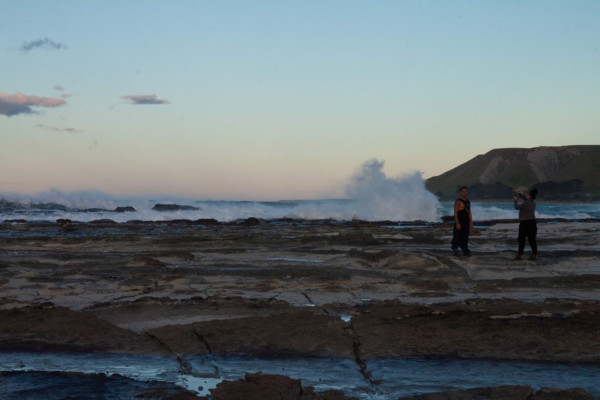
Taane Mete and Terri Crawford - Kahungunu dancers ancestral mauri wānanga, Auroa Point, Māhia. Desna Whaanga-Schollum 2023.
So, a lot of your mahi is there to support our researchers and the work that they do?
A lot of our whānau-hapū-based researchers are passionate about the work that they do, and I see my role as ensuring that the ideas they come up with are connected to some of the wider policies and strategies that are at play.
So [my role is] bringing more of a strategic, broad lens to the implementation space, so that whatever gets created by our researchers is going to be practically useful or applied. It doesn't just sit on someone's computer, or on a bookshelf, or in a report — there's actually some usefulness of the work that comes out of it.
That can be quite difficult because often there’s a time lag between the work we create and how everyone else sees the utility of the thing you've created. For example, the work that we did in the low impact urban design space was 18 years ago, and with the recent kind of climate extremes, that type of mahi [is now seen as useful].
In Phase One of the Challenge we did create ideas around co-governance of the marine environment, and a few years later we're starting to see people being responsive to it.
Oftentimes, it's a matter of the timing of a lot of issues and kaupapa as to whether people will want to see the utility or the benefits of the work that you create as a researcher. As researchers, we're just going to be mindful of that and patient. As research leaders understand, it does take people time to catch up.
Do you have thoughts on the timeline to see change happen, and how that sits within whakapapa - an ancestral paradigm?
As Māori researchers, what we bring to these types of conversations and to the National Science Challenges, is that our horizons in terms of benefits to Aotearoa and benefits to whānau and hapū are much longer-term. We understand that change does take time. From our experience of working with colleagues and working with the wider research system and in wider society, it does take a while for people to understand and appreciate the value of Indigenous approaches.
There's also a learning aspect to — understanding that there are limitations to the economic growth model. You can see people wanting to find alternatives. So, they’re leaning towards Indigenous perspectives to be informed by these types of approaches. I think that's a really challenging space because the dominant narratives about economic growth at times overstate the benefit and don’t value sustainability kōrero or a kaupapa Māori approach.
It becomes a matter of trying to reconcile those values. And you have to wait until people are ready to do that — to grow beyond selfish personal wealth accumulation. To be looking at appreciating that there are benefits to sharing our resources not only for ourselves, but for future generations.
When you've been brought up with that ethic in mind, especially when you gather kai, your Koro or your dad might be telling you‚ ‘Hey leave some kai for someone else to come along’. This is in direct contrast to others who might go out and fish up to the limit like, ‘Oh yeah, let's grab that whole bag and‚ we’re entitled to X amount of crays and X amount of pāua’. It’s disconnected from what the carrying capacity of that ecosystem might be. When you have that disconnection between people and the environment, and information around monitoring all those effects, then you're going to have perverse outcomes.
It’s important that we continue that dialogue, about promoting ethical-based approaches that are very much long-term. And we hope that our partners are going to get to the same space that we're in, but we're probably going to have to drag our partners along on the journey of achieving those outcomes for healthy marine environments.
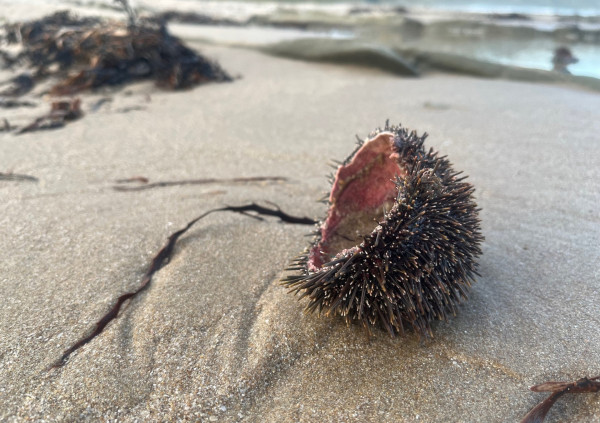
Kina shell, Taipōrutu beach, Māhia. Desna Whaanga-Schollum, 2023
What is your favourite moana-related word or phrase?
The karakia Whakataka te hau and the explanation of it by Judge Joe at the Ngā Pae o te Maramatanga conference some years ago, really resonates.
Whakataka te hau ki te uru,
Whakataka te hau ki te tonga,
Kia makinakina te uta,
Kia mataratara ki tai,
E hi ake ana te atakura.
He tio, he huka,
he hau hu(nga).
Tihei mauri ora.
He was saying that, its’ that moment when it's calm outside; the westerly wind, which is now the prevailing wind, has died down. And then the southerly wind it’s died down as well.
Being coastal people around the East Coast, we know that the westerlies can be a bit hoha when it's like a strong north-westerly. So you're hoping for that nor-westerly wind to be dying down and you're hoping for that southerly to be dying down as well so that it's all still and calm on land. And it’s just a little bit of a hint of a frost.
If you've ever been out on those cool autumn days out on the water, just at sunrise, it's just so, so magical on the East Coast. Definitely on the East Coast, around Māhia, here around Gisborne and so on. When you're on the water, you can see the sun just about to rise. That's when you feel connected to the environment and you feel connected to your people. As they're experiencing the same phenomena, that, based on that karakia, you're experiencing at that time as well.
But I think that might be changing, unfortunately. Because of La Niña, you can see that the predominant winds are mostly northerly and easterly winds. And so that might change up once we get back into El Niño when we get more northerly. Is the north-westerly coming through? We might experience that phenomena, but I doubt that over the spring and summer the Gisborne has experienced the very phenomena that expressed in that karakia.
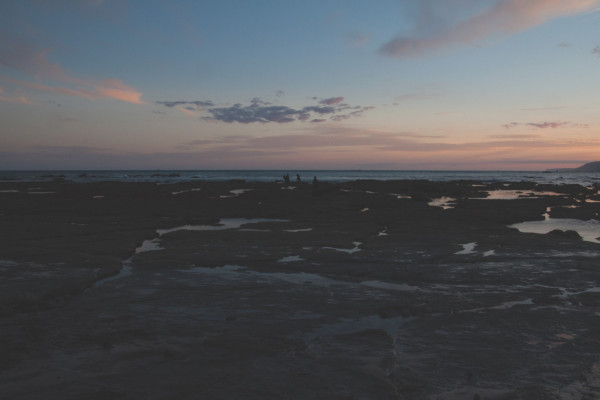
Kaimoana gathering, reef at Māhia, 2012. Desna-Whaanga-Schollum
How would you describe the current state of our moana in Aotearoa?
I'm not a kaitiaki. I'm not a personal marine scientist, but anecdotally, after kōrero with whānau and seeing some of the images after the recent rain events around that East Coast-Tairawhiti rohe, it's not in a good state — especially if after rains, slash comes down, washes up on the beaches, and sediment comes down as well. And then you've got pāua, crayfish-koura all intermingled and mixed up, dead, in amongst the slash. When I talk to my mum, who lives in Gisborne, and she likes to go for a hikoi down at the beach every day, she's saying that she can't do that anymore because all the slash that's on the beaches.
It’s increasingly a cost for communities, not only in terms of having resources available to clear away the debris from those beaches. But it also cost the life of a young boy who lost his life after playing on the logs on the beaches.
The ability for whānau to be able to go there and engage with the moana is restricted or limited because of the debris on the beaches. There's that much debris that you can't walk on the beach. I think about that young boy and I think that that could have been us after Cyclone Bola because it's such a huge temptation to go walking along those logs when they’re deposited on the beach.
They connect up and you think about those images of those Canadian loggers running on the river along those big-as logs. And so, you try to do the same thing, which can be a bit dangerous. It was, unfortunately, dangerous for that whānau and I really feel for them. And I also think, ‘jeez we used to do that sort of thing’.
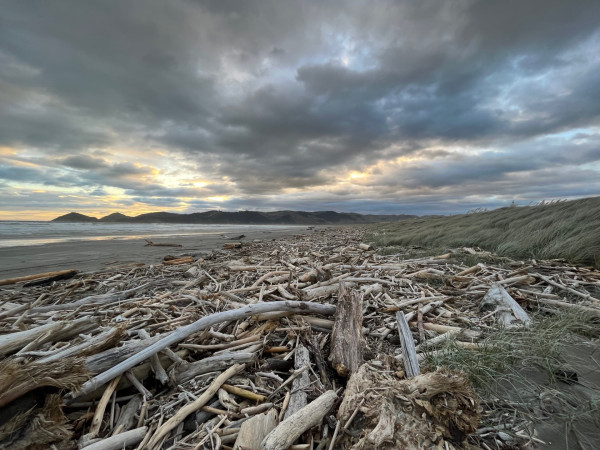
Cyclone Gabrielle slash, Māhia Beach, May 2023. Desna Whaanga-Schollum
What would you say is the biggest challenge for marine management at the moment?
The biggest challenge is for society to balance its priorities. We've got kaitiaki who are promoting the longer-term focus of how we manage the marine environment. We've got scientists and environmental advocates who are promoting ethics around sustainability. That all comes into play, or to a head, with local fishers who just want to keep doing what they've been doing, as well as industry, who are driven by priorities for making profit.
Often politically, the most focus is on ensuring that we maximise profit. Profit over people and profit over the environment, which drives how wider society engages with the natural environment. We need to reconcile that space and come to a balance between all the different priorities. Wider society needs to accept that extreme forms of capitalism have been detrimental to the natural environment — along with those land-based activities from deforestation, and along with other land-based activities from dairy.
Until society wakes up and realises the cause of all these negative externalities that are happening to the natural environment — from climate change through to acidification of our oceans, and sedimentation of our oceans — then we're going to be in a dire state. Society must reconcile with the long-term aspirations of kaitiaki, alongside ensuring that we manage our resources in a manner that is viable for long-term sustainability.
The conversations will continue between ourselves as researchers and wider society in order to achieve that aspiration for the long-term sustainability of the oceans.
What is one action that people could take to support the moana that aligns with your work at Sustainable Seas?
Like in the climate change space, a lot of the issues are systemic. So often we look towards individuals to change their behaviour. That will affect some change, but the issue is really a systemic one, and it's driven from capitalism, by greed — by the need for profits. Until those agents of profit maximisation change their behaviour, it's going to be incredibly difficult for the individual to be able to effect change.
So, we're reliant on politicians to have the political will to make sure that they are listening to kaitiaki — listening to people who are interested in the long-term sustainability and survivability of those ecosystems. Until politicians start listening to us who are keenly interested in long-term inter-generational equity, then they're going to be forever beholden to economic interests that will drive the agenda within Aotearoa.
I think as individuals, it's probably not so much about changing up consumer behaviours, but really putting pressure at a local level or putting pressure on our politicians that we expect better of them — in terms of looking after the marine environment and that they ought not to prioritise the needs of a few companies to the detriment of wider society.
This is difficult because of the narrative within Aotearoa that economic growth is the ‘be all and end all’ of how society is organised. In the past few years, there has been a significant blowback in terms of a wellbeing-focused type of approach for our economy — of taking more of a manaaki or a caring approach to the economy for how we manage our resources.
We're seeing the blowback in terms of the negative attitudes towards Jacinda Ardern and the approach that she was implementing, which was supportive, at times, of the sustainable agenda. But when you take progressive steps, conservative elements within society rally against that and become quite violent almost. We saw those occupations at Parliament and the online hatred towards Jacinda Ardern and others involved in this type of alternative agenda. This agenda that promotes collective wellbeing runs in contrast to the individualistic behaviour that New Zealanders have been indoctrinated into for the past 40 years since rolling back the state that the 1984 Labour Government implemented.
I think until we get to that space where we’re mature enough to be able to recognise that, collectively, civil institutions lead a pathway towards change, then it's difficult for an individual to be able to affect change.
Do you feel our communities are aware of this indoctrinated thinking and the dominant narratives that prioritise industrialisation, development, capitalism, and market forces?
I’m feeling worried — social media has really undone some of the social contract that we have in society. Along with this, social media is also a successful indoctrination of the society. I’m talking about wider society, and I'm talking about our people as well — the way that they live their lives. A lot of our people, whānau and hapū, are disconnected, and their priorities are around Rights or subscriptions to their influence-based lifestyles.
It really disheartens me, and I think there's very few people that you have to rely on in times of crisis or need. And they're the ones who are carrying the load for our communities, not only the on-the-ground-care, but providing the information, being the information conduits around what behaviour is expected or what ways people can become empowered or support themselves through times of crisis.
So, the whole erosion of our norms and ethics as Māori, the ethics around manaaki, but also kaitiaki, really worries me as people become more focused on other priorities in their lives. I think the way around it is probably better education initiatives where kura ensure that the rangatahi have practically based teaching programmes that align to how you interact with the natural environment.
Those are cool initiatives, but a lot of the tamariki or rangatahi don't have those opportunities because there are probably not enough resources available for them to be able to have that more environmentally focused connection within the class.
And then, you know, for our other rangatahi, the focus and priorities are on other different things. I think we're really good at promoting kapa haka and waka ama and touch rugby and so on, but really poor at promoting the connection between the natural environment and people. We don’t value that. But we will definitely say how awesome so and so is at doing a haka, but not so much around, ‘look how many possums they tracked’ or ‘look how many crayfish they counted. Look how they restore the ecosystem in those kina barrens’‚ or something like that. We don’t value that type of mahi enough.
I hope that at Matatini there's going to be waiata that reflect the impacts of activities on the environment, climate change, and restoring the mauri of the moana. I really hope that they compose waiata around that. That's probably a way to help generate some change amongst our rangatahi and those who are in that kind of reo kapahaka space.
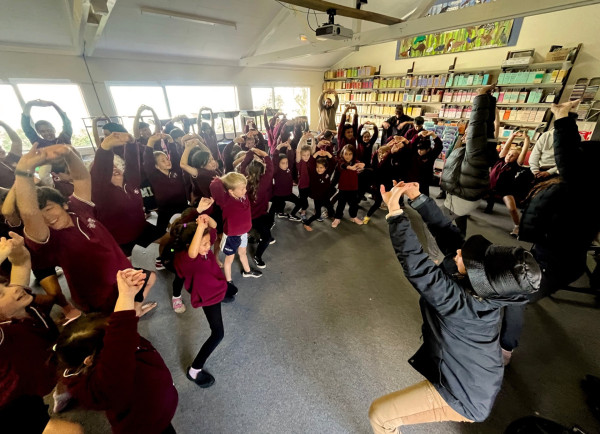
Te Māhia Primary School rangatahi - Kahungunu dancers ancestral mauri wānanga, Māhia. Desna Whaanga-Schollum 2023
